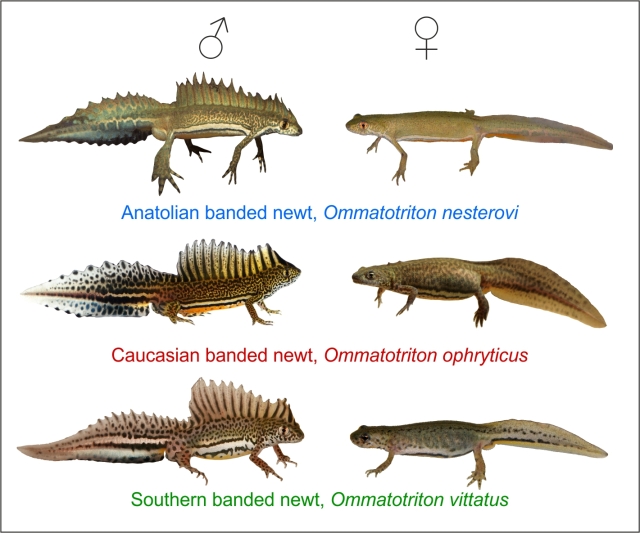Genetic studies in the family Salamandridae have regularly revealed cryptic species – genetically distinct species that previously went unrecognized due to their morphological similarity. The most recent salamandrid example is provided by the banded newts (genus Ommatotriton). While the split between the southern banded newt (O. vittatus) versus ‘O. ophryticus’ is generally accepted, this is not the case for the further split of the latter taxon into the Caucasian banded newt (O. ophryticus sensu stricto) and the Anatolian banded newt (O. nesterovi). From morphology O. vittatus is known to be distinct, but no differences are known to separate the other two banded newt species.

Pictures of the three banded newt species, courtesy of Michael Fahrbach, Sergé Bogaerts, and the late Bayram Göçmen and Max Sparreboom. The vernacular names are newly proposed in this study.
Based on a superficial inspection of photographs, it seemed to me that two ‘band’ characters might be useful for species identification. Now, based on a survey of almost 700 museum specimens, we show in a paper in Salamandra that in O. nesterovi the lateral white band generally I) continues from the front limbs up to the eye and II) is interrupted by large specks on the tail, while this is generally not the case in O. ophryticus (see the figure above). In the third member of the genus, O. vittatus, both character states for each ‘band’ character occur at similar frequency, but the lateral white band is considerably broader compared to the other two species. Hence, all three banded newt species can be identified from morphology.
Reference: Üzüm, N., Avcı, A., Olgun, K., Bülbül, U., Fahrbach, M., Litvinchuk, S.N., Wielstra, B. (2019). Cracking cryptic species: external characters to distinguish two recently recognized banded newt species (Ommatotriton ophryticus and O. nesterovi). Salamandra 55(2): 131-134.


Pingback: More resolution for the beautiful banded newts | Wielstra Lab
Pingback: Hybrid zone analysis confirms cryptic banded newt species | Wielstra Lab